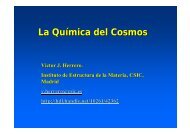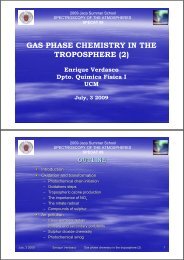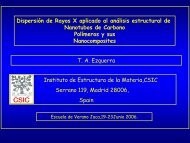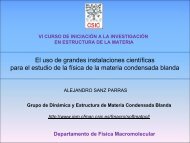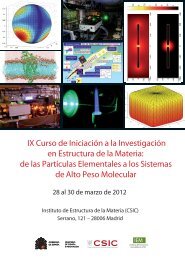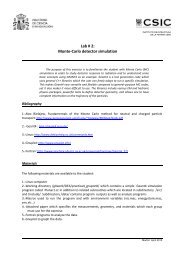Download the slides
Download the slides
Download the slides
Create successful ePaper yourself
Turn your PDF publications into a flip-book with our unique Google optimized e-Paper software.
S. Tsujikawa, J. Ohashi, S.Kuroyanagi, A. De Felice, arXiv: 1305.3044 <br />
Tokyo University of Science, Shinji Tsujikawa
Proposed to resolve several cosmological problems plagued<br />
in big bang cosmology, e.g.,<br />
Horizon <br />
problem <br />
Flatness <br />
problems <br />
Responsible for <strong>the</strong><br />
origin of structure <br />
Starobinsky , Guth , Sato , Kazanas ( early 1980’s) <br />
・・・Cosmic acceleration around <strong>the</strong> energy scale
Old inflation (Sato, Kazanas, Guth) <br />
1. <br />
602 citations <br />
3. <br />
Inflationary universe: A possible solution to <strong>the</strong> horizon <br />
and flatness problems <br />
Alan H. Guth* <br />
Stanford Linear Accelerator Center, Stanford University, <br />
Stanford, California 94305 <br />
Received 11 August 1980 <br />
4414 <br />
citations <br />
2. <br />
168 citations
l “Old’’ inflation <br />
Inflationary models <br />
Many inflationary models have been proposed so far. <br />
l Curvature inflation <br />
The higher-‐order curvature term leads to inflation. <br />
Lagrangian: <br />
Starobinsky (1980) <br />
Inflation occurs due to <strong>the</strong> first-‐order phase transition of a vacuum. <br />
Sato (1981), Kazanas (1980), Guth (1981) <br />
l Slow-‐roll inflation <br />
(first model of inflation) <br />
Inflation is driven by <strong>the</strong> potential energy of a scalar field. <br />
New, chaotic, power-‐law, hybrid, natural, extra-‐natural, eternal, D-‐term, <br />
F-‐term, brane, oscillating, tachyon, hill-‐top, KKLMMT, … (too many) <br />
l K-‐inflation <br />
Inflation is driven by <strong>the</strong> kinetic energy of a scalar field. <br />
Ghost condensate, DBI, Galileon,… <br />
l Inflation in extended <strong>the</strong>ories of gravity. <br />
Brans-‐Dicke, Higgs, Horndeski’s <strong>the</strong>ory,…. <br />
There are also multi-‐field models.
Standard slow-‐roll inflation <br />
S =<br />
⇤<br />
d 4 x ⇥<br />
ä<br />
a = 8 G<br />
3<br />
V ( )<br />
V (⇥)<br />
Inflation occurs under <strong>the</strong> condition <br />
g<br />
⇥<br />
R<br />
16 G + X V (⇥)<br />
On <strong>the</strong> FLRW background, <strong>the</strong> scale factor obeys <br />
˙2<br />
˙⇥2 ⇥<br />
X = 1 (⇥ )2<br />
2<br />
V ( )<br />
Slow-‐roll <br />
The field evolves slowly along a <br />
nearly flat potential (slow-‐roll). <br />
In this case <br />
H<br />
Cosmic acceleration <br />
ȧ<br />
a ⇥ const. a e H inf t
Perturbations <br />
Inflaton <br />
fluctuations <br />
⇥<br />
P R<br />
Primordial <br />
spectrum of <br />
curvature <br />
perturbations <br />
CMB temperature anisotropies <br />
from inflation <br />
k<br />
Larger scales <br />
Scalar spectral index <br />
k<br />
Smaller scales <br />
( 68% CL )<br />
The primordial power spectrum is nearly scale-‐invariant.
S =<br />
⇤<br />
d 4 x ⇥<br />
g<br />
⇥<br />
R<br />
16 G + X V (⇥)<br />
Scalar perturbations <br />
Tensor perturbations <br />
ds 2 =<br />
(1 + 2A)dt 2 +2 i Bdtdx i + a 2 (t) [(1 + 2R) ij + h ij ] dx i dx j<br />
Scalar <br />
S (2)<br />
s = dtd 3 xa 3 Q s Ṙ 2 c 2 s<br />
a 2 ( R)2<br />
For standard potential-‐driven inflation <br />
Q s =<br />
˙2<br />
c 2<br />
2H 2 , s =1<br />
The amplitude of curvature perturbations <br />
can be estimated by solving <strong>the</strong> equation <br />
of motion which follows from <strong>the</strong> above <br />
action. <br />
<br />
<br />
<br />
<br />
The conditions for <strong>the</strong> avoidance <br />
of ghosts and Laplacian instabilities <br />
Q s > 0 c 2 s > 0<br />
,
The CMB observations can discriminate between different potentials. <br />
Scalar spectrum: <br />
where <br />
Tensor spectrum: <br />
where <br />
Tensor-‐to-‐scalar ratio: <br />
The Planck constraints are <br />
r
Discrimination between inflaton potentials <br />
Lyth bound: <br />
Smaller r <br />
(i) Large-‐field inflation (e.g., chaotic inflation, 1983) <br />
During inflation <strong>the</strong> field evolves <br />
over <strong>the</strong> large-‐distance: <br />
<br />
(ii) Small-‐field inflation (e.g., natural inflation, 1990) <br />
During inflation <strong>the</strong> field evolves <br />
over <strong>the</strong> small-‐distance: <br />
A. Linde (young version) <br />
K. Freese <br />
(iii) Hybrid inflation (1994) <br />
Inflation ends due to <strong>the</strong> waterfall transition <br />
to <strong>the</strong> global minimum. <br />
A. Linde (current version)
Potential-‐driven slow-‐roll inflation <br />
Planck 2013 results. XXIII. Isotropy and Statistics of <strong>the</strong> CMB : arXiv:1303.5083
S.T., J. Ohashi, S. Kuroyanagi, A De Felice, arXiv: 1305.3044 <br />
Potential−driven slow−roll inflation<br />
10 0 Inclusion of high L data prefers <br />
Planck+WP+BAO+high L <br />
<strong>the</strong> smaller spectral index. <br />
Planck+WP+BAO <br />
4<br />
power law inflation<br />
10 −1<br />
2<br />
1<br />
r 0.05<br />
natural<br />
2/3<br />
10 −2<br />
large−field<br />
small−field<br />
R 2 inflation<br />
10 −3<br />
very<br />
small<br />
field<br />
hybrid2<br />
hybrid1<br />
0.94 0.95 0.96 0.97 0.98 0.99 1 1.01<br />
n s
Inflation in extended <strong>the</strong>ories of gravity <br />
Most general single-‐field scalar-‐tensor <strong>the</strong>ories with second-‐order equations of motion <br />
Horndeski (1974) <br />
Deffayet et al (2011) <br />
Charmousis et al (2011) <br />
This action covers most of <strong>the</strong> dark energy models proposed in literature. <br />
l Potential driven inflation: <br />
l K-‐inflation: <br />
l f(R) gravity and scalar-‐tensor gravity: <br />
l Galileon: <br />
l Gauss-‐Bonnet coupling <br />
:
Horndeski’s paper in 1973
Second-‐order actions of scalar perturbations <br />
We consider scalar metric perturbations <br />
, ⇥, R<br />
with <strong>the</strong> ADM metric <br />
ds 2 = [(1 + ) 2 a(t) 2 e 2R (⇤⇥) 2 ] dt 2 +2⇤ i ⇥ dt dx i + a(t) 2 e 2R dx 2<br />
We choose <strong>the</strong> uniform field gauge: =0<br />
The second-‐order action of scalar perturbations in <strong>the</strong> Horndeski’s <strong>the</strong>ory reduces to <br />
S 2 = dtd 3 xa 3 Q Ṙ2 c 2 s<br />
a 2 ( R)2<br />
Q>0 and c 2 s > 0 are required to avoid<br />
ghosts and Laplacian instabilities.<br />
where <br />
Q = w 1(4w 1 w 3 +9w 2 2)<br />
3w 2 2<br />
, c 2 s = 3(2w2 1w 2 H w 2 2w 4 +4w 1 ẇ 1 w 2 2w 2 1ẇ 2 )<br />
w 1 (4w 1 w 3 +9w 2 2 )<br />
w 1 = MplF 2 4XG 4,X 2HX ˙G 5,X +2XG 5,<br />
w 2 =2MplHF 2 2X ˙G 3,X 16H(XG 4,X + X 2 G 4,XX )+2˙(G 4, +2XG 4, X )<br />
2H 2 ˙(5XG5,X +2X 2 G 5,XX )+4HX(3G 5, +2XG 5, X )<br />
w 3 = 9MplH 2 2 F + 3(XP ,X +2X 2 P ,XX ) + 18H ˙(2XG 3,X + X 2 G 3,XX ) 6X(G 3, + XG 3, X )<br />
+18H 2 (7XG 4,X + 16X 2 G 4,XX +4X 3 G 4,XXX ) 18H ˙(G 4, +5XG 4, X +2X 2 G 4, XX )<br />
+6H 3 ˙(15XG5,X + 13X 2 G 5,XX +2X 3 G ,5XXX ) 18H 2 X(6G 5, +9XG 5, X +2X 2 G 5, XX )<br />
w 4 = MplF 2 2XG 5, 2XG 5,X ¨
Power spectrum of curvature perturbations <br />
where <br />
Kobayashi et al. (2011) <br />
De Felice and S.T. (2011) <br />
where
Tensor power spectrum <br />
Tensor perturbations: <br />
The second-‐order action is <br />
where <br />
The tensor power spectrum is <br />
The tensor-‐to-‐scalar ratio is <br />
These results can be readily used for concrete models of inflation. <br />
e.g., <br />
where <br />
These observables depend on <strong>the</strong> slope of <strong>the</strong> potential.
We can apply our general results to a variety of inflation models. <br />
Standard potential-‐driven inflation <br />
P ( ,X)=X V ( )<br />
f(R)<br />
gravity <br />
Brans-‐Dicke <strong>the</strong>ories <br />
Non-‐minimally coupled models <br />
Galileon inflation <br />
Field-‐derivative couplings <br />
Running kinetic couplings <br />
k-‐inflation <br />
etc… <br />
S = d 4 x g<br />
M 2 pl<br />
2 R + P ( ,X) G 3( ,X) + L 4 + L 5<br />
L 4 = G 4 ( ,X) R + G 4,X [( ) 2 ( µ )(<br />
µ<br />
)]<br />
L 5 = G 5 ( ,X) G µ (<br />
µ<br />
)<br />
1<br />
6 G 5,X[( ) 3 3( )( µ )(<br />
µ<br />
) + 2(<br />
µ<br />
)( )( µ )]
Inflation in f(R) gravity <br />
The slow-‐roll parameter is <br />
Starobinsky (1980) <br />
First model of inflation <br />
Inflation occurs due to <strong>the</strong> presence <br />
of <strong>the</strong> quadratic curvature term. <br />
Inflation ends around <br />
(quasi-‐exponential expansion)
Planck constraints on Brans-Dicke gravity with <strong>the</strong> potential<br />
Brans−Dicke <strong>the</strong>ories<br />
The observables are <br />
10 0 Starobinsky’s f(R) model <br />
10 −1<br />
BD<br />
=10 2<br />
BD<br />
=10 10<br />
where N is <strong>the</strong> number of <br />
e-‐foldings from <strong>the</strong> end of <br />
Inflation. <br />
r 0.05<br />
10 −2<br />
BD<br />
=1<br />
BD<br />
=0<br />
10 −3<br />
10 −4<br />
BD<br />
=−1.4<br />
0.945 0.95 0.955 0.96 0.965 0.97 0.975 0.98<br />
n s
Einstein frame <br />
Jordan frame: <br />
Confomral transformation <br />
Einstein frame: <br />
where <br />
Einstein frame potential <br />
Under observational <br />
pressure <br />
The potential is nearly flat. <br />
Consistent with observations.
Higgs inflation <br />
There are several ways to accommodate Higgs for inflation. <br />
Bezrukov and Shaposhnikov (2008) <br />
Nakayama and Takahashi (2010), <br />
De Felice, S.T., Elliston, Tavakol (2011) <br />
Germani and Keghagias (2010) <br />
Kamada, Kobayashi, <br />
Yamaguchi, Yokoyama (2010)
Planck constraints on non-minimally coupled chaotic inflation <br />
Non−minimally coupled models<br />
r 0.05<br />
10 −1<br />
10 −2<br />
=0<br />
(a)<br />
=−6.0<br />
×10 −3<br />
10 0 Favored observationally.<br />
(b)<br />
=−2.0×10 −3<br />
=−0.1<br />
=−10 4<br />
=0<br />
(a) n=2<br />
(b) n=4<br />
10 −3<br />
0.94 0.95 0.96 0.97 0.98<br />
n s<br />
We also have <br />
/⇠ 2 ' 4.3 ⇥ 10 10
Running kinetic couplings <br />
0.3<br />
0.25<br />
Running kinetic coupling models<br />
µ=0<br />
(b)<br />
(a) n=2<br />
(b) n=4<br />
The dilatonic running coupling <br />
leads to <strong>the</strong> decrease of r. <br />
r 0.05<br />
0.2<br />
0.15<br />
µ=0.1<br />
µ=−0.03<br />
µ=0<br />
However both <strong>the</strong> quadratic <br />
and quartic potentials are <br />
outside <strong>the</strong> 68 % CL boundary. <br />
0.1<br />
0.05<br />
(a)<br />
µ=0.1<br />
µ=10<br />
µ=10<br />
This comes from <strong>the</strong> fact that <br />
Planck data give tight upper <br />
bounds on <strong>the</strong> scalar spectral <br />
index than that of WMAP. <br />
0<br />
0.945 0.95 0.955 0.96 0.965 0.97 0.975 0.98<br />
n s
Field derivative couplings to <strong>the</strong> Einstein tensor <br />
0.25<br />
0.2<br />
Field−derivative coupling models<br />
(b)<br />
(a) n=2<br />
(b) n=4<br />
This coupling leads to <strong>the</strong> slow-‐down <br />
of <strong>the</strong> velocity of inflaton, which <br />
leads to <strong>the</strong> decrease of r. <br />
For smaller M, <strong>the</strong> scalar spectral <br />
index gets larger. <br />
r 0.05<br />
0.15<br />
0.1<br />
smaller M<br />
(a)<br />
Both <strong>the</strong> quadratic and quartic potentials <br />
are outside <strong>the</strong> 68 % CLboundary. <br />
0.05<br />
A similar conclusion was reached for <br />
<strong>the</strong> Galileon couplings. <br />
0<br />
0.945 0.95 0.955 0.96 0.965 0.97 0.975 0.98<br />
n s
f NL<br />
B R f NL<br />
・・・nonlinear estimator of primordial scalar non-Gaussianity (NG) <br />
R(k 1 )R(k 2 )R(k 3 )⇥ = (2⇥) 3 (3) (k 1 + k 2 + k 3 )B R (k 1 ,k 2 ,k 3 )<br />
Deviation from <strong>the</strong> Gaussian distribution <br />
Equilateral <br />
Local <br />
k 1 k 2<br />
Observations <br />
WMAP <br />
f equil<br />
NL<br />
= 51 ± 272<br />
Planck <br />
k 1 k 2<br />
k 3 k 3<br />
f equil<br />
NL<br />
= 42 ± 75<br />
Theory <br />
Standard slow-‐roll inflation <br />
L = X V ( )<br />
Observations <br />
Theory <br />
WMAP <br />
f local<br />
NL = 37 ± 40<br />
Planck <br />
f local<br />
NL =2.7 ± 5.8
Non-Gaussianities in <strong>the</strong> Horndeski’s <strong>the</strong>ory <br />
l Local shape: <br />
Under <strong>the</strong> slow-‐variation approximation, <strong>the</strong> non-‐linear estimator is <br />
Same as that derived by <br />
Maldacena in standard <br />
slow-‐roll inflation (2002). <br />
Gao and Steer (2011) <br />
A. De Felice and S.T. (2011) <br />
The small local non-‐Gaussianity in <strong>the</strong> squeezed limit is a generic <br />
feature in <strong>the</strong> single-‐field slow-‐variation inflation. <br />
l Equilateral shape: <br />
The leading-‐order non-‐linear estimator is
Observational constraints on power-law k-inflation <br />
The power-‐law inflation can be realized by <strong>the</strong> Lagrangian <br />
(dilatonic ghost condensate) <br />
In this case <strong>the</strong> observables are <br />
c s<br />
>0.079<br />
0.02 0.04 0.06 0.08 0.1<br />
c s<br />
Generally <strong>the</strong> k-‐inflation models <br />
are tightly constrained from <strong>the</strong> <br />
equilateral type NG.
Summary <br />
Overall, <strong>the</strong> single-‐field small-‐field models with <br />
are favored.
Potentials favored from observations <br />
(Einstein frame) <br />
Natural inflation




